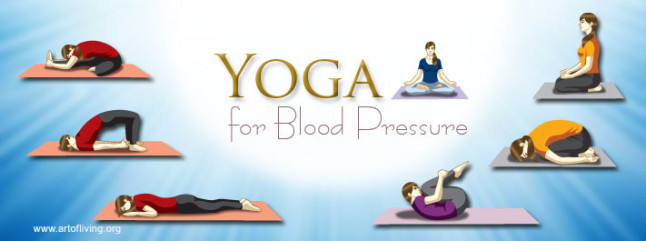High blood pressure can lead to heart attacks, strokes, and other cardiovascular diseases. Yoga and pranayama are a natural way to improve blood circulation in the body and treat both high blood pressure (hypertension) and low blood pressure(Hypotension) problems.
What causes high blood pressure?
Essential Hypertension, which is the most common type of hypertension found, is an independent condition, meaning it is not triggered by other medical conditions like diabetes, heart-related problems or kidney malfunctioning. The dominant reason for this type of high blood pressure problem is stress. When you’re under stress, your heart beats faster and your blood vessels start to narrow, making stress a long-term cause of hypertension. Bad habits like smoking and alcohol consumption may be substantial in causing high blood pressure. Lack of physical activity, being overweight and obesity is another root cause of Hypertension.
Low Blood Pressure : Low blood pressure or Hypotension is a physical condition where the blood pressure levels fall below 90/60 mmHg. Doctors believe that low blood pressure is not really harmful until it starts causing dizziness, fainting, and even shock.
Low blood pressure can be caused due to various reasons such as low blood volume, anemia, nutritional deficiency, heart problems, and hormonal changes amongst others. In advanced cases, it may cause lack of oxygen supply and nutrients to the brain and other vital organs.
How yoga helps to cure blood pressure?
- Yoga in complement with conventional medical treatment can be helpful in reducing the dosage of High Blood pressure drugs and it may even relieve patients of medicines altogether.
- Yoga gives positive energy, makes managing a healthier lifestyle possible. It increases immunity and reduces heart problems like heart attacks and strokes.
- Yoga Asanas can soothe the nerves and slow the heart rate. Doing yoga stretches regularly keeps the arteries ductile and reduces the stiffness of the arteries, thereby lowering blood pressure.
- Pranayama and conscious breathing also slow the heart rate and revitalizes the cardiovascular system.
- Meditation is a remedy for the stress of modern day lifestyle. It brings the nervous system into balance.
- Regular practice of yoga and an improved diet also keep the body weight in check.
Regular practice of yoga benefits the body in the following ways:
- It improves digestion, circulation and immunity
- Yoga enhances function of neurological and endocrine organs
- It prevents and provides relief from chronic illnesses, such as:
- High blood pressure
- Chronic pain syndromes
- Anxiety and panic disorders
- Depression
- Sleep disorders
- Chronic fatigue syndrome
- Hyper Tension
Yoga for high blood pressure
The following yoga asanas (yoga poses) and pranayamas are effective in lowering blood pressure. They should be learned with proper guidance before putting it into practice.
- Sukhasan
- Full Yogic breathing
- Bhramari
- Janusirsasana
- Paschimottanasana
- Purvottanasana
- Shavasana
- Ardh-halasana
- Setu Bandhasana
- Variation on Pawanmuktasana (circular movements with knees without lifting the head up)
- Lie down on the stomach
- Makarasana with Bhramari pranayama
- Shishuasana
- Vajrasana
- Suptvajrasana
- Stretch the legs and come into savasana
- Yoga Nidra
Yoga for low blood pressure
These pranayamas and yoga asanas improve blood circulation, relieve the body of stress and fatigue and uplift the mind. They are effective in treating low blood pressure problems.
- Kapal Bhati pranayama
- Uttanasana
- Adho Mukha Svanasana
- Pavanmuktasana
- Shishuasana
- Sarvangasana
The Sri Sri Yoga attends to every aspect of an asana from start to finish, as well as the breath-work. Below yoga asanas (yoga poses) and pranayamas are effective in lowering blood pressure. They should be learned with proper guidance before putting it into practice.
Description Of some Of the asanas for blood pressure
Corpse Position (Shavasana)
- You may want to use a sweater, socks or a blanket to keep yourself warm during final relaxation
- Lie on your back
- Take a breath in and tense your whole body from head to toes: hold your breath, clench your fists, and squeeze all facial muscles as well as every single muscle in the body
- Breathing out through the mouth with a “haaa” sound, release your muscles
- Repeat one more time
- Now lie in a position that feels comfortable to you. Keep the eyes closed
- Mentally relax all parts of the body by taking your awareness to all parts of the body in turn, starting at the feet and ending with the head, feeling grateful for each part of the body. Gratefulness adds to the physical and mental relaxation
- Let Mother Earth take all your weight, feeling the body to be very light. A relaxed body feels light.
- Next, allow your breath to relax by becoming aware of it and making it soft, small and quiet
- Now allow your mind to relax by letting go of any worries, fears, anxiety or excitement. For the time being, let go of any future plans or past events
- Rest in the peaceful and blissful space within you
- After resting for a few minutes, bring your awareness back to your body and take a couple of deep breaths
- Gently roll over onto your right side
- Slowly come up to the sitting position
- Chant Om three times
Child's Pose (Shishu Asana)
- Sit on your heels. Keeping your hips on the heels, bend forward and lower your forehead to the floor
- Keep the arms alongside the body with hands on the floor, palms facing up. (If this is not comfortable, you can place one fist on top of another and rest your forehead on them.)
- Gently press your chest on the thighs and relax in this position
- Slowly come up to sit on the heels, uncurling vertebra by vertebra, and relax
Benefits
- Deeply relaxing for the back
- Relieves constipation
- Calms the nervous system
Interested in yoga classes?



